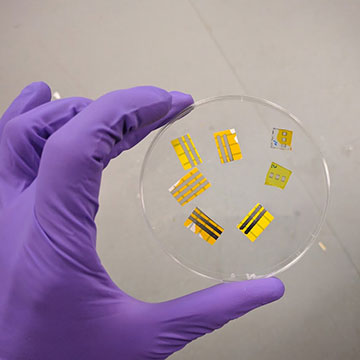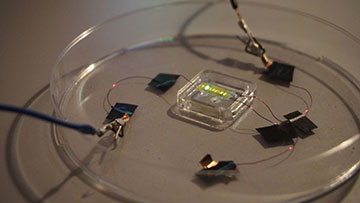
Here, a researcher holds a glass slide with several of the 2.3-μm-thick transferrable OLED tattoos. [Image: J. Barsotti - Italian Institute of Technology]
Temporary tattoos may have just graduated from a child’s party favor to an enabling platform for ultraflexible and conformable displays. Researchers in Italy and the U.K., inspired by the simple wet-and-stick transfer mechanism of temporary tattoos, have demonstrated a transferable, ultrathin, green organic light-emitting diode (OLED), which they fabricated on commercially available tattoo paper (Adv. Electron. Mater., doi: 10.1002/aelm.202001145).
According to the team, this is the first demonstration of ultrathin OLED tattoos—a landmark that could, it says, set the stage for future on-skin and disposable electronic applications.
On-skin sensing
Skin-wearable sensors have the potential to carve out large application areas in fields like biomedicine, sports science and environmental monitoring; however, device stiffness is a major roadblock to this goal. Reducing the thickness and increasing the flexibility of displays—a fundamental component of flexible electronic-device architecture—is one avenue scientists are pursuing to boost the conformability of these devices.
OLEDs are already commonly used to illuminate flat-screen TVs, smartphone displays and computer monitors, but progress in fabricating thin, flexible OLED displays could open up an array of applications, particularly when integrated with electronic skin and wearable devices.
The research team behind the new work has been investigating tattoo electronic technologies for years, focusing on using organic materials to realize electronic components on ultrathin substances. So, fabricating an OLED on a tattoo substrate “appeared to us as a natural evolution of our research,” says Virgilio Mattoli at the Italian Institute of Technology.
Stick and glow

The team transferred the OLED tattoo device to a freestanding PVF nanosheet to demonstrate the feasibility of an ultrathin free‐standing OLED. [Image: J. Barsotti - Italian Institute of Technology]
The proof-of-concept device consists of five layers, assembled using several deposition processes. First, the researchers treated the commercial tattoo paper with an inert polymer layer to prepare the surface for the next steps. Next, they ink-jet printed a transparent electrode (the conducting polymer layer) on the surface, which was then covered by a photo-electroactive polymer (the green-emitting active layer) via spin coating. Finally, the team patterned an aluminum reflective electrode on top using thermal evaporation—resulting in a 2.3-μm-thick transferrable OLED tattoo.
This fabrication process, the researchers note, is fairly low cost and scalable; however, they point out, a full ink-jet printing fabrication process could make it even more affordable and open up more applications. The light emission, though lower than what’s achievable with a standard glass OLED structure, was “remarkable,” the team writes, considering the device was characterized in ambient conditions, after exposure to water and without any encapsulation.
Once assembled, the tattooable OLED can be applied the same way that one would apply a conventional temporary tattoo—by placing it on virtually any surface, dabbing the substrate with water and then sliding the paper sheet away. In experiments, the team applied these light-emitting tattoos to a glass slide, a plastic bottle, an orange and to paper packaging—they even demonstrated the device on a freestanding nanosheet. Once applied to a surface, the team wired the devices and switched them on so that the OLED tattoos glowed green—an exciting moment that Franco Cacialli at University College London, U.K., referred to as “first light.”
“We were acutely aware of the potential for failure due to a large variety of reasons, spanning from water/air contamination, to damage during the transfer procedure,” Cacialli explained. “There were so many steps that could fail, so actually seeing that it worked after all our apprehension was an elating experience.”
Future optimization
In addition to on-skin displays for healthcare or personal monitoring, Mattoli notes that the tattooable OLEDs could be used for the photoactive curing of surfaces, or even just for skin or fingernail decoration. Another interesting possibility for OLEDs is their use in visible-light communications, or Li-Fi; in such a scheme, OLED tattoos could conceivably be used to establish temporary communications links.
The researchers note some kinks that must be worked out, however, before such applications can be realized. According to Cacialli, the first challenge is encapsulation, followed closely by efficiency.
“In our work we used standard and low-performance materials configured in a standard minimal architecture, just to demonstrate the concept,” he said, “whereas by using high-performance materials and advanced architectures, we expect it could be possible to improve the emitting performance by an order of magnitude or two.”
